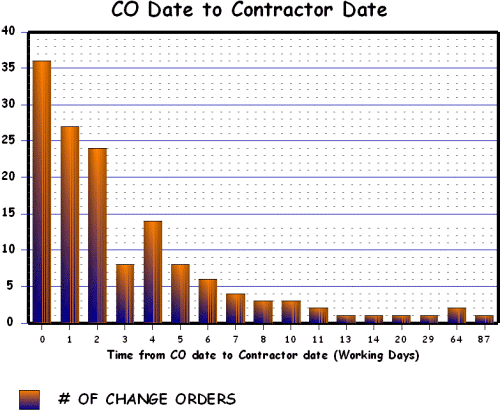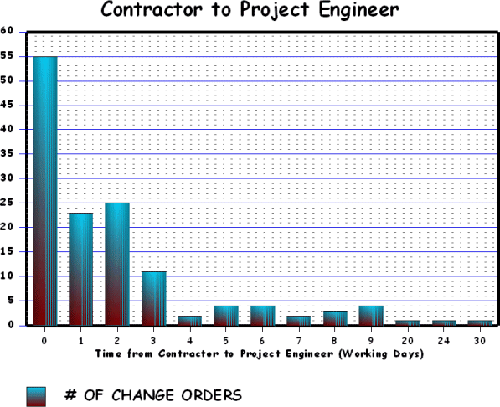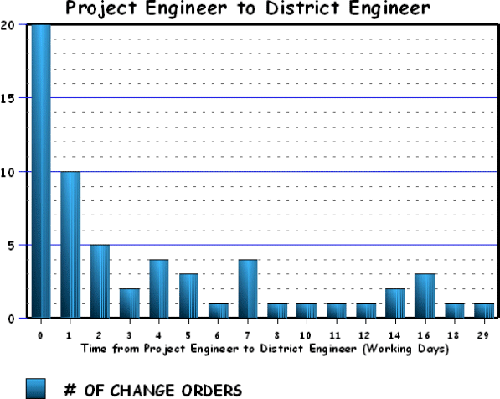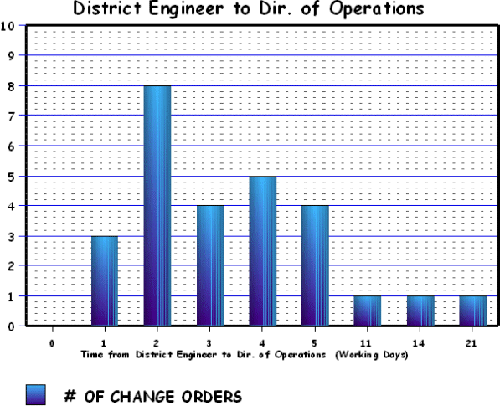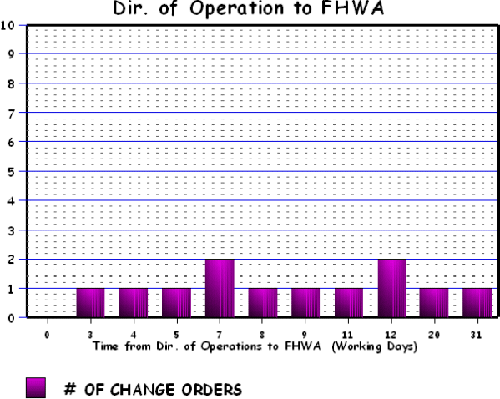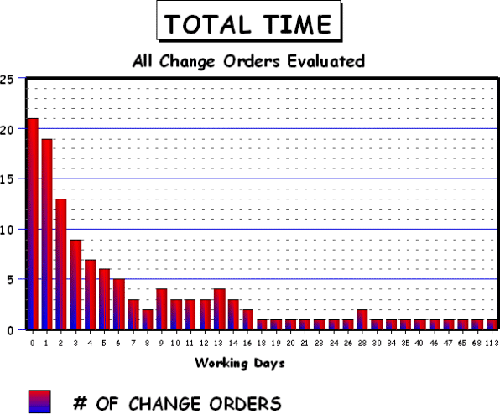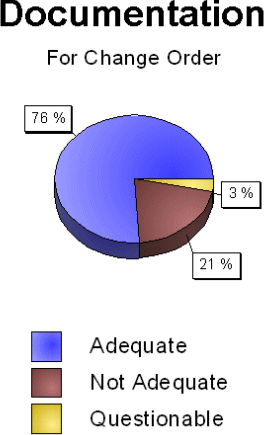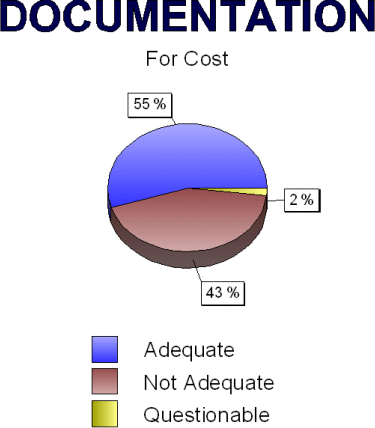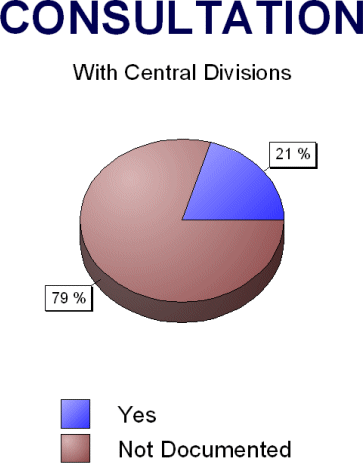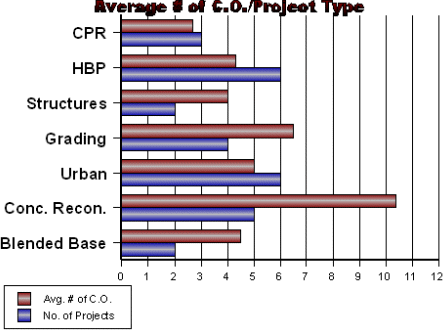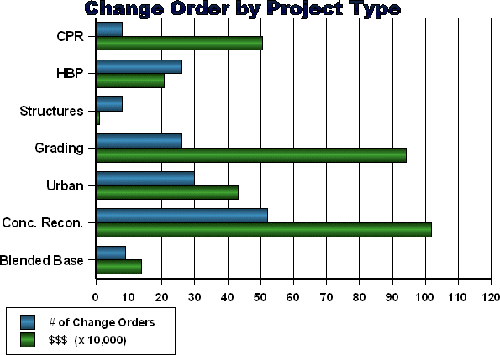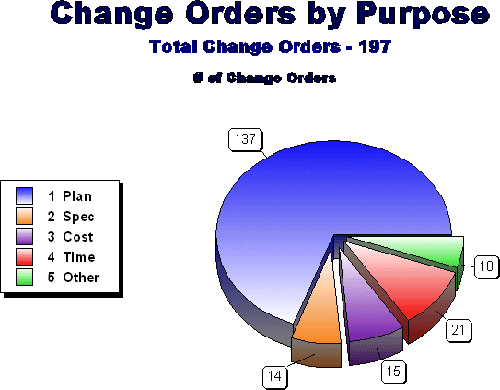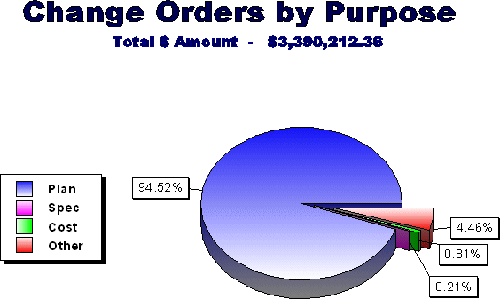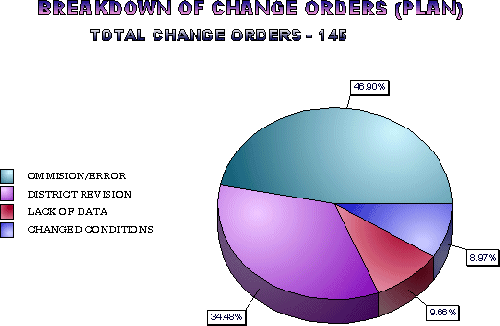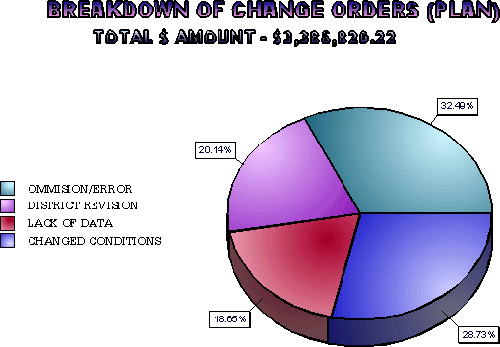(State) Department of Transportation
And
Federal Highway Administration (State) Division
Process Review On Change Orders
Word Version (2.4 mb) | PDF Version (0.5 mb)
March 2001
| Report by: | ......STA ......FHWA ......FHWA |
-
Introduction
A. Background
The mission of Federal Highway Administration (FHWA) is to continually improve the quality of our Nation's highway system, and its intermodal connections. This is accomplished through building and strengthening relationships with state Departments of Transportation, improving efficiency through managerial and administrative changes, and assisting in the implementation of technology and innovation. In an effort to make such improvements, the (State) Division and the (State) Department of Transportation (STA) have jointly completed a review of the change order process in the STA construction program.
During the past year, the (State) Division office noticed that there were times when a change order requiring FHWA approval, did not receive approval until after the work on the change order had been completed, or that the approval had not been processed in a timely manner. Additionally, there were several occurrences where FHWA's approval was never requested when it should have been. This led to questions about whether improvements could be made to the current STA / FHWA change order approval process. As a result, the (State) Division decided to perform a process review on change orders.
On December 7, 2000, a meeting was held with STA and FHWA to discuss the scope of the review. Management and Staff from both were in attendance. The Construction Services Division was interested in utilizing findings from the review, because they were planning to perform their own review of change orders and were in the process of updating the STA Field Office Procedures Manual. In that meeting, it was decided that the review should be a joint effort, so that any findings would be mutually beneficial. The review team members were selected, and a work plan and schedule were approved. The approved work plan and schedule can be found in Appendix A. of the STA Construction Services Division, and of FHWA were chosen to perform the review. They were requested to present their findings to STA and FHWA management by March 15, 2001.
B. Review Objectives
The purpose of the review was to:
- Identify patterns in the preconstruction and the construction process which lead to change orders.
- Determine the timeliness of FHWA's change order response for the past construction year.
- Verify that the change order approval process is consistent with 23 CFR 635, STA Standard Specifications, and STA Field Office Procedures Manual.
After a detailed review focused on these three areas, the goal was to make recommendations for improvement to FHWA and STA.
C. Review Approach
Project Selection
For the year 2000, STA contracted approximately $150,000,000 worth of projects (excluding county projects). For this work a total of 541 change orders were processed. The 541 change orders consisted of 461 on the State system and 80 on the county system.
In order to get an accurate representation of the change order process, the review team decided to select a random sample of projects from the 2000 construction season, and review in detail, all change orders from those projects. A total of 159 change orders, from 28 projects (21 contracts, since some projects are tied) were reviewed. The original contract amount of these 28 projects is $91,675,260. The projects covered locations throughout the State, with at least one project from each District. They ranged in size from $293,899.60 to $11,818,564.32. Various types of projects were reviewed, including Portland Cement Concrete (PCC) pavement reconstruction, Concrete Pavement Repair (CPR) and Dowel Bar Retrofit, Grading, Hot Bituminous Pavement (HBP), Mine and Blend, Structural, and Urban Reconstruction.
Data Collection and Analysis
The detailed review of the change orders required extracting all information from each change order that was relevant to the change order process. All items associated with cost, contract time, approval time, items of work, documentation, and reason for or explanation of changes were tracked. A spreadsheet was created to facilitate analysis of the data. The spreadsheet is in Appendix B.
Input from Districts
In addition to data collection and analysis, the review team put together a short questionnaire designed to get some idea of how the Districts feel the change order process is currently working. The questionnaire contained 15 questions relating to approval and documentation requirements, reasons for change orders, and ways to reduce the number of change orders and make improvements to the process. After submitting the questionnaire to the Districts by E-mail, a teleconference or meeting was held with construction personnel from each of the Districts, to discuss the change order process. The teleconference or meeting was held with each District separately. The information gathered from these discussions was essential in helping the review team determine where improvements should be made in the process. Many of the Districts had the same responses to the questions, and several good suggestions for improvements were received. The questionnaire and a summary of the responses are in Appendix C.
-
Observations
A. Time for Processing Change Orders
The evaluation of time for processing change orders was broken down into groups to isolate trends. These groups are Change Order date to Contractors' signature date, Contractors' signature date to Project Engineers' signature date, Project Engineers' signature date to District Engineers' signature date, District Engineers' signature date to Director's of Operations signature date, and Director's of Operations signature date to FHWA's signature date.
The first group evaluated was the Change Order date to Contractor's signature date. Of the 159 change orders that were selected for this review only 142 could be evaluated. Ten change orders did not have the date when the contractor signed and seven change orders had errors in the change order dates created by a program named CARS. CARS prints a creation date on the change order. This creation date is based on the date stored in the computer where the program resides. Therefore, if the project engineer does not set the date on the computer correctly, the date printed on the change order will be incorrect. The graph in Figure 1 shows the workdays which transpired between the Change Order date to the Contractor's signature date. As seen in the graph, the majority (61%) of the contractors signed the change orders within two days of the Change Order Date.
Figure 1
Total Change Orders evaluated - 142
Average of 4.41 daysThe second group evaluated was the Contractor's signature date to the Project Engineers' signature date. Of the 159 change orders only 136 could be evaluated due to omissions of contractor (10) and project engineer (13) dates. The graph in Figure 2 shows the workdays which transpired between the contractors' signature date and the project engineers' signature date. Approximately 76% of these change orders were signed within two days by the Project Engineers.
Figure 2
Total Change Orders evaluated - 136
Average of 2.25 daysThe third group evaluated was the Project Engineers' signature date to the District Engineers' signature date. Of the 159 change orders only 72 change orders required the approval of the District Engineers. Of the 72 change orders only 60 could be evaluated. The review team agreed that one change order needed the approval of the District Engineer. Eleven other change orders did not have the date when the District Engineers signed them. The graph in Figure 3 shows the workdays which transpired between the Project Engineers' signature date and the District Engineers' signature date. Approximately 58% of these change orders were signed within two days by the District Engineers.
Figure 3
Total Change Orders evaluated - 60
Average of 4.25 daysThe fourth group evaluated was the District Engineers' signature date to the Director's of Operations signature date. Of the 159 change orders reviewed only 30 required the approval by the Director of Operations. Of these 30 change orders, 27 were evaluated. The review team agreed that two of the change orders needed the approval of the Director of Operations. The third change order that was not evaluated was not dated by the District Engineer. The graph in Figure 4 shows the workdays which transpired between the District Engineers' signature date and the Director's of Operations signature date. Approximately 40% of these change orders were signed within two working days by the Director of Operations. The average time for the Director of Operations to sign a change order was 4.33 days.
Figure 4
Total Change Orders evaluated - 27
Average of 4.33 daysThe fifth group evaluated was the Director's of Operation signature date to FHWA's signature date. Only 15 change orders needed FHWA's approval. Of these 15 change orders, 12 were evaluated. The review team agreed that two of the change orders needed approval by FHWA. The third change order that was not evaluated was not signed by the Director of Operations. The graph in Figure 5 shows the workdays which transpired between the Director's of Operations signature date and FHWA's signature date. No change orders were approved by FHWA in less than three working days. It should be noted that the average time for the original copy of the change orders to be delivered to FHWA from STA is 2.67 working days. FHWA approves change orders on the average of 10.75 days. Subtracting out the delivery time, a more accurate average is approximately 8 working days.
Figure 5
Total Change Orders evaluated - 12
Average of 10.75 daysThe total processing time from the start of a change order to the date of the last signature required was also evaluated. Of the 159 change orders, 125 could be tracked by date from start to finish. The graph in Figure 6 shows the total processing time in working days versus the number of change orders. 60% of the change orders were processed within 5 working days. The average total processing time is 9.14 working days.
Figure 6
Total Change Orders evaluated - 125
Average of 9.14 daysThe table below contains some of the general findings from this portion of the review.
General Findings Number of Change Orders Evaluated 159 Number of Change Orders which could be tracked from beginning to end 125 Number of District Engineer approvals needed 72 Number of Director of Operations approvals needed 30 Number of FHWA approval needed 15 Omission of Project Engineers' dates 13 Omission of Contractors' dates 10 Omission of District Engineers' dates 11 Occurrence of Contractors' signature dates before change order dates 7 Occurrence of Project Engineers signing before Contractors 41 District Engineer approvals needed 1 Director of Operations approvals needed 2 FHWA approvals needed 2 B. Change Order Documentation
While reviewing the change orders, the review team used the following principles as a guide in determining if the change orders were justified. The principles are:
- Plans do not fit field situations.
- Found a way to build the same quality for less cost.
- Found a way to build it better.
- Contract must be better for owner/public after the change.
As part of the data collection efforts, the review team made a determination about the level of documentation on each change order. As shown on the spreadsheet in Appendix B, this was broken down into several different categories. These included:
- Documentation for the change order, or in other words, an explanation of what work was done and why
- Documentation for cost, or justification, of the agreed upon price
- Documentation of changes affecting environmental commitments
- Documentation of consultation with the Central Division Offices
- Documentation of prior or verbal approval by FHWA.
It should be stated that the result is based on the review team's collective opinion. Each member of the review team reviewed each change order and after a discussion, came to agreement about whether or not the documentation was adequate.
What the review team found is that documentation is one area where significant improvements could be made. Out of 159 change orders, 126 contained adequate documentation for the change order. This information is presented in Figure 7. In other words, 76 percent adequately explained the need for the change and how it was resolved. Seventy-six percent is good, although there is room for improvement. Some of the change orders did a good job explaining the work to be done, but lacked adequate explanation of why the change was needed or how the change results in a better overall product. For example, on one project, a new bridge rail was installed. The change order was for removing the end blocks that were part of the old bridge. The explanation was as follows, "The end blocks were part of the old bridge rail design. The new rail retrofit does not utilize the end blocks. Since there is no purpose for the end blocks, they will be removed." The explanation of the work to be done is clear, but why was it necessary? Was removal of the end blocks necessary for installation of the new rail? Could they have been left in place without compromising safety? Were they removed for the convenience of the contractor? Does this change result in a better product?
Figure 7
From the analysis of the documentation for cost, the review team found that considerably fewer change orders contained adequate justification for the agreed upon cost. Only 87 of the 159 adequately documented the change order cost. That is, only 55 percent included what the review team felt was necessary to justify the cost. Figure 8 presents this information. Many of the change orders reviewed contained no documentation of any kind of cost comparison. Some change orders simply attached the letter from the contractor stating his/her prices. Others provided a generic statement such as, "The additional cost submitted by the contractor is reasonable." or "The prices for the above work includes prime contractor markup, materials, equipment, and labor required to complete the work." The review team felt that these were inadequate.
Figure 8
There was no documentation on any of the change orders addressing environmental commitments. Without more information, the review team was unable to determine whether all environmental commitments had been met. Since there were several change orders that may have had environmental concerns, it is likely that some explanation of environmental effects and actions taken, should have been included. For example, there were several change orders addressing changes to drainage, one change order for removing a concrete fuel tank from an old gas station, and two change orders for additional clearing and grubbing.
Consultation with the Central Division Offices was not documented on 126 of the 159 change orders. The Central Division Offices include, Materials and Research, Design, Bridge, and Construction Services. As presented on Figure 9, only 21 percent of the change orders documented consulting with the Central Division Office. The review team recognizes that it is not necessary for the Project Engineer to contact the Central Division Offices on every change order. However, there were many change orders which the District or project engineers should have consulted with the appropriate division and there was nothing indicating that they had been involved in the decision. For example, one change order reduced the width of geotextile fabric in the subcut from 68' to 42' and there was no documentation showing that this had been approved by Materials and Research. This could be considered a significant design change. Another change order was needed to fix a drainage problem at a crossover that had been built the previous year on a separate contract. Part of the work on this change order included blocking up the Jersey barriers to allow a faster flow of storm water under them. This action affected safety. There was no documentation that the Design Division was contacted or consulted regarding this change order.
Figure 9
Documentation of prior or verbal approval by FHWA was not included on any of the 12 change orders that required FHWA approval. There were six occasions where FHWA had given verbal approval before the change order was issued, but the verbal approval was not documented on the change order. This information was available to the review team only because they were directly involved.
The fact that many of the change orders lack the appropriate documentation does not necessarily mean the change order process is not working. Most likely, the change orders were processed correctly and appropriate decisions were made at the appropriate level. It does indicate, however, that guidance or training on change order documentation is needed so Project Engineers know what is required when submitting change orders. Proper documentation of the change order will help ensure that the right decision is made and will aid the reviewing officials when approving the change order.
C. Change Order Cost and Purpose
The original contract amount for the 28 projects selected is $91,675,260. The net increase from change orders on these 28 projects (based on the change orders executed as of 12/1/00) is $3,235,690 or 3.5%. Overall, the increase due to change orders does not appear to be extreme. However, when looking at some of the individual projects, increases by change orders on multi-million dollar projects of over 21% are present, which should trigger the need for some type of improvement in one or more areas of the overall project development or construction process.
The 28 projects reviewed were separated into 7 major project types. The seven types are concrete reconstruction, concrete pavement repair (CPR) and Dowel Bar Retrofit, grading, hot bituminous pavement (HBP), mine and blend, structural, and urban reconstruction. This was done to determine if there was any relationship between the type of project and the number or dollar value of change orders on those projects. The following observations are based on Figure 10:
- Concrete Reconstruction projects generate the largest number of change orders on average.
- Grading projects generate the second largest number of change orders on average.
- The data for the Urban projects is based in part on some small-scale projects and therefore may not necessarily represent what would be typical for a large-scale urban reconstruction project.
- CPR projects generate the least number of change orders on average.
Figure 10
Figure 11 also compares project type to change order data collected. From this figure the following observations were made:
- Concrete Reconstruction and Grading projects accounted for the majority dollar value of change orders reviewed.
- There were half as many Grading project change orders as Concrete Reconstruction project change orders, but the dollar value of those change orders is nearly equal.
- Approximately the same number of HBP, Urban, and Grading project change orders were reviewed. Of these three, the dollar value of the grading project change orders was more than twice that of urban projects, which in turn is more than twice that of the HBP projects.
- The data for the CPR project type may be misleading. $400,000 worth of the change order costs is attributed to one change order, which actually concerned a structure located on the CPR project.
Figure 11
Part of reviewing the 159 change orders consisted of categorizing change orders by purpose. The review team classified the change orders into 5 different categories. A description of the categories is listed below. The classification of each change order is identified on the change order spreadsheet (Appendix B) under the "Purpose" column, with the numbers 1, 2, 3, 4 or 5.
- Plan: Change orders regarding plan errors and omissions, added work, changes in quantities, changing design details/requirements, and issues of this nature.
- Specification: Change orders specifically regarding changes to the standard specifications.
- Cost: Change orders that deal with value engineering proposals, price deducts, fuel cost adjustments, and issues of this nature.
- Time: Change orders regarding adjustments to the contract time.
- Other: This category is for change orders that did not seem to fit in any of the other four categories, it includes change orders for partnering, haul roads, construction zone radios, etc...
Figure 12 shows the distribution of change orders among the five "Purpose" categories. It should be noted that some change orders fall into more than one category. For example, a change order may be the result of a plan change that also adds contract time to the project. In this case, the change order is placed in both the Plan(1) and Time(4) categories. Therefore, the total change order number of 197 shown at the top of the figure is greater than the 159 actual change orders evaluated, due to some change orders being classified into multiple categories.
Figure 12
The obvious observation from Figure 12 is that the majority (70%) of the change orders fall into the "Plan (1)" category.
Figure 13 reinforces this observation and actually shows that based on the dollar value of the change orders, over 94% of the change order dollar value is attributed to the "Plan (1)" category. Note that the "Time (4)" category is not included in Figure 13, since the dollar value of the change order was not associated with time adjustments on the change order.
Figure 13
Since the "Plan" category consisted of such a large portion of the purposes for change orders, the review team decided to further analyze this group of change orders. The "Plan" change orders were sorted into four groups. The four groups along with an explanation of each group are listed below:
- Errors and Omissions: Issues where it was felt that the causes for the change orders could or should have been included in the plans prior to the bid opening. These change orders are for items such as missing or wrong bid items, missing or wrong quantities, etc...
- Changed Conditions: Issues regarding subgrade problems.
- Lack of Data: Issues regarding conditions that were unknown at the time of plan preparation and discovered during construction. Items such as buried structural components in poor condition, abandoned fuel tanks, separated pipe, etc...
- District Revision: Issues regarding additional work not anticipated during the design stage, design changes done to improve the project or in the public interest, etc...
The following tables list the four groups with a breakdown of the different change order items and how often they occur in each group. Figures 14 and 15 provide graphical displays of the same information.
Errors and Omissions
No. CO Item Explanation 2 Attenuation Devices Added, replaced with guardrail because no room 2 Bridge Items Add roadway canopy, remove asphalt on deck, curb 1 Clearing and Grubbing Not included in plans 4 Concrete Barriers For pier protection, no bid item, no pins 1 Geometric Changes Not approved at bid opening 4 Guardrail Add cable for safety, remove for construction 3 HBP Removal Obliterated areas, and HBP removal not in plans 1 Maintenance of Roadway Not included in plans 2 Pavement Marking Removal of temporary, changes 10 Pipes Add end sections, end cover, at x-over, at intersection 5 Quantities Class 5, common excavation, borrow 1 Rumblestrips Added after bid opening due to policy change 2 Safety Fence Bridge painting 5 Signing Add for rest area, speed limit, posts too short, wrong size 2 Survey Errors Relocate pipe 6 Traffic Control Add message board, light plant, vertical panels, warning system, remove interim signal 1 Use MS-1 not CSS-1H Used wrong bid item Changed Conditions
No. CO Item Explanation 11 Subgrade Problems Add fabric, underdrain, pit run gravel, remove unsuitable material Lack of Data
No. CO Item Explanation 1 Add Pipe Encountered spring 3 Approach Slabs Damage discovered during construction 1 Buried Manhole Manhole discovered at x-over location 1 Deck Replacement Poor condition required replacement instead of overlay 1 Pier Repair Damage discovered during construction 1 Remove Concrete Shoulder Plans did not show PCC 1 Remove Fuel Tank Concrete tank from old gas station 2 Replace Footing, Abutment Poor condition discovered during construction 1 Replace Manhole Covers Rusted out, discovered at construction 2 Replace Pipe Pipe separated, damaged RCES District Revision
No. CO Item Explanation 1 Abandoned Service Lines Shut off 4 Approaches Add HBP, add driveway, add PCC driveway 1 CPR Repair WB lanes 3 Crossovers Change HBP thickness, Add PCC, repair 8 Drainage Design change, city requested change, relocate underdrain, fix drainage at x-over, change PVC to RCP 1 Expedite paving Pave 4 miles of primed surface 2 Fabric Reduce width, use fabric in lieu of subcut 4 Grade Change Slope flattening, add survey, pipes, adjust manhole 1 Guardrail Eliminate attenuation device and add guardrail 1 Hand Paving Changes at 39th St. 1 Joints Changed from 15' to random joint spacing 2 Lighting Change from conventional to high mast, 2 extra for city 1 Median Pier Use PCC instead of HBP 1 Parking Lot Use PCC instead of HBP 3 Piling Size changed due to availability 3 Reinforcement Expose 4" rather than 18" of rebar, epoxy coated 1 Remob, Mill and Scale To eliminate temporary service gravel 1 Remove Bridge End Blocks 1 Repair Slope Slide 1 Scarify and Prime Surface 2 Signing Add, eliminate 1 Straw Mulching Eliminate 2 Survey Outside project limits 1 Traffic Control Maintenance 1 Widen Turn Lane Figure 14
Figure 15
D. Miscellaneous
During the change order process review, the review team took an in-depth look at all 159 change orders. Besides the observations noted above, the team documented other possibly significant issues or problems that we felt are worth mentioning and analyzing. These issues are generally not widespread throughout the STA, however they are worthwhile discussing since in most cases they appear to be practices that should not continue or are not beneficial to the overall mission of the STA. The following is a list of these issues and observations made by the review team regarding them:
- Consultants performing construction engineering on STA projects located in cities where the consultant also acts as the city engineer for that city. Reviewing the change orders on this particular project resulted in questions on the use of Federal funds for some of the work. It appeared to the review team that some of the change order items should be classified as 100% city funds, but were not. There appears to be a potential conflict of interest when the consultant acts as the project engineer for the STA and the city engineer on a project located within the city limits.
- Renegotiating change orders after they have been executed.
- Executing change orders after the work is completed.
-
Conclusions
Overall the change order process is working well. However, the review allowed the team to identify patterns in the preconstruction and construction phases that lead to change orders. Plan changes accounted for the majority of the change orders. Plan changes are comprised of omissions or errors on the plans, revisions made by the District, changed conditions, and other instances where design data was insufficient.
During the interviews with the Districts, they felt that more involvement by the Districts in the plan preparation process would reduce the number and/or dollar value of change orders. More involvement included such things as having more opportunities to review plans prior to the final PS&E meeting and assigning the project engineer early on in the design phase so he/she could assist with the plan preparation.
Another observation made by the team is that insufficient design data accounted for the majority of change order costs. Most of these large costs are from changes caused by subgrade problems. When the Districts were asked to identify which aspect of a project they felt generated the greatest number or dollar value of change orders, they overwhelmingly responded with subgrade. The Districts also felt that providing the contractors with more information on existing conditions would help reduce the number of change orders.
The review of change order approval time found that it takes on average 9 days to process a change order. The team's observation is that the time it takes to approve and process a change order has not been a problem. Other than one instance where a time extension was requested by the contractor, the processing time of a change order has not been a time extension factor. On a small scale, there was some concern by a few Districts that the change order processing time did hold up payment to the contractor.
One area that the team felt where significant improvement could be made is in the documentation of change orders. In particular, it was felt that the documentation of change order costs could be improved. This is based on the team's opinion that only 55% of the change orders reviewed had adequate documentation for cost. It appears that this issue could be improved upon by providing the project engineers with better tools, more guidance, and training on change order documentation. This was also reiterated by the Districts during the interviews, in that most of their requests for training dealt with change order documentation and price justification.
The current change order approval process is in compliance with all State and Federal requirements. However, there seems to be some inconsistencies on determining when FHWA and STA upper management approval is needed. Specifically, there was confusion concerning when a change order is a design change or specification change. It should be noted that the STA change order approval process is currently being updated and these issues will be addressed.
-
Recommendations
- Training examples for FHWA Contract Administration Course that will be held April 17 and 18, 2001, in (State). Examples may include documentation of change orders, approval authority, processing change orders, and determination of Federal-aid eligibility.
- Develop in-house training regarding STA change order procedures. This training could cover documentation of change orders, approval authority, processing change orders, and determination of Federal-aid eligibility.
- Develop guidelines for price justification.
- Develop guidelines for documentation.
- Develop a policy in regards to the selection of Consultants representing more than one interest (i.e., City and STA).
- Implement a procedure which would allow more time for District plan review.
- Reevaluate procedures used to collect and distribute design data.
- FHWA should create a flowchart to aid STA personnel in determining who to contact regarding change order approval.
- Districts should fax/E-mail a rough draft of the change order prior to verbal approval to any higher approval authority (including FHWA) if they know their approval will be needed.


